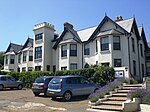Isle of Wight Festival 1970
The Isle of Wight Festival 1970 was a music festival held between 26 and 31 August 1970 at Afton Down, an area on the western side of the Isle of Wight in England. It was the last of three consecutive music festivals to take place on the island between 1968 and 1970 and often acknowledged as the largest musical event of its time, with a larger attendance than Woodstock. Although estimates vary, Guinness World Records estimated 600,000 to 700,000 people attended. It was organised and promoted by local brothers, Ron and Ray Foulk through their company Fiery Creations Ltd and their brother Bill Foulk. Ron Smith was site manager and Rikki Farr acted as compere. The preceding Isle of Wight Festivals, also promoted by the Foulks, had already gained a good reputation in 1968 and 1969 by featuring acts such as Jefferson Airplane, Tyrannosaurus Rex, the Move, the Pretty Things, Joe Cocker, the Moody Blues (performed at the 1969 festival), the Who, and Bob Dylan in his first performance since his 1966 motorcycle accident. Many excerpts from this festival have appeared on record and video.
Excerpt from the Wikipedia article Isle of Wight Festival 1970 (License: CC BY-SA 3.0, Authors).Isle of Wight Festival 1970
Newport Road,
Geographical coordinates (GPS) Address Nearby Places Show on map
Geographical coordinates (GPS)
| Latitude | Longitude |
|---|---|
| N 50.676 ° | E -1.489 ° |
Address
Newport Road
Newport Road
PO40 9UF
England, United Kingdom
Open on Google Maps









